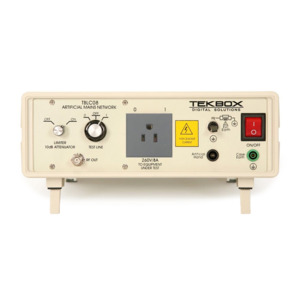
- Description
- Specifications
- Documents
TBLC08 - 50uH 8A AC Line Impedance Stabilisation Network LISN
Specs:
- Frequency range: 9 kHz to 30 MHz
- Impedance: 50 ohm ¦ (50 µH + 5 ohm)
- Artificial hand: 220 pF + 511 ohm
- Switchable PE: 50 ohm ¦ 50 µH
- Limiter / attenuator: 150 kHz to 30 MHz; 10 dB
- Air core inductors
- Line voltage input: 110-240 VAC. Rear IEC 60320 C1 connector
- Includes 120VAC line voltage power cord
The TBLC08 is a Line Impedance Stabilization Network for the measurement of line-conducted interference within the range of 9kHz to 30MHz, according to the CISPR16 standard. The device is designed for testing single phase, AC-powered equipment with supply voltages up to maximum 240V. Conducted noise can be measured on the phase and on the neutral conductor. The TBLC08 is equipped with a switchable limiter/attenuator and an artificial hand connection. The device is available with country-specific DUT connectors
Pre-compliance testing of conducted emissions
Full compliance measurement of AC mains supplied products requires a high end set up consisting of an anechoic or screened chamber, a measurement receiver that complies with the requirements of CISPR 16, a 50µH LISN and a suitable table for the measurement setup. Great effort and cost ensures optimum accuracy and repeatability.
Pre-compliance measurements target to give an approximation of the EMC performance of the Device Under Test at a fraction of the cost of full compliance testing. The measurement receiver can be replaced by a spectrum analyzer with suitable sensitivity, bandwidth and detectors. The advent of affordable spectrum analyzers with EMI detectors such as the DSA815 from Rigol or similar products made EMC pre-compliance testing affordable for any company which develops electronic products. Together with test accessories from Tekbox, EMC pre-compliance set-ups cost hardly more than a standard oscilloscope a few years ago.
Eliminate uncertainty before going to the test house for compliance testing. There is hardly anything that can give you a return on invest as quickly as EMC pre compliance test equipment.
Any LISN (line impedance stabilization network) is basically a kind of filter. A LISN is always inserted between the supply input terminals of the DUT (Device Under Test) and the supply which is used to power the DUT. It presents a defined impedance for the noise which is produced by the DUT and emitted via the supply cables of the Device Under Test. The impedance seen by the RF emissions is 50 Ohms¦ 50µH which results in 50 Ohms for the most part of the specified frequency range. Only at the lower edge of its bandwidth, the impedance decreases. This impedance curve is specified in the corresponding test standards. Having a defined impedance for the emissions at the DUT terminals eliminates any influence of the power source impedance.
